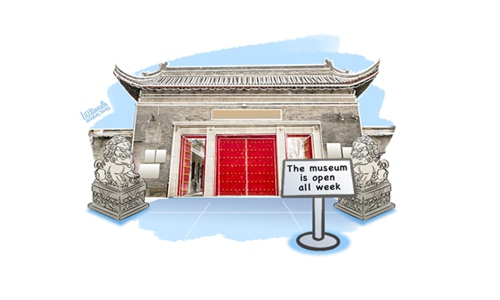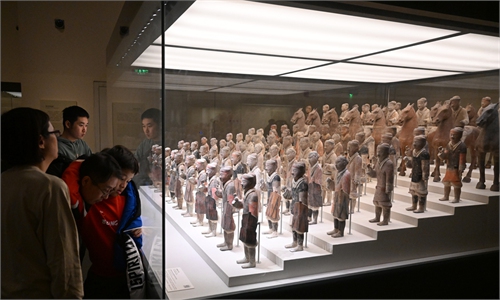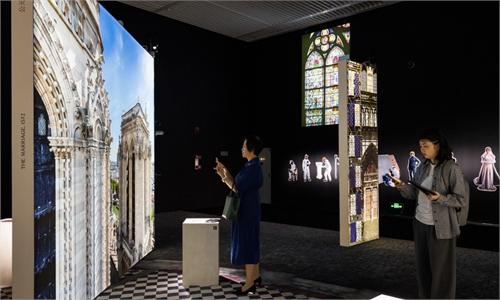ARTS / CULTURE & LEISURE
May Day holidays spark surge in nighttime museum experiences
New cultural consumption model emerging

Hubei Provincial Museum Photo: VCG
The May Day holidays have long been a peak season for cultural tourism in China, often marked by a surge in public enthusiasm for museums and heritage sites. In 2025, a growing "museum fever" has been further fueled by a wave of nighttime cultural offerings - from after-dark exhibitions to open-air performances and markets - bringing fresh vitality to cities across the country.As night fell, museums and cultural venues across the country offered extended hours and an expanded lineup of evening programs, reflecting a growing emphasis on nighttime cultural experiences.
For example, the Hubei Provincial Museum opened for four consecutive nights; the Shaanxi History Museum extended its hours until 9:30 pm; and the China Grand Canal Museum stayed open until 9 pm while also launching 100 public education and intangible cultural heritage events.
In Nanjing, East China's Jiangsu Province, a series of evening performances including traditional music and a costume show drew large crowds to the historic Zhanyuan Garden; the Grand Bao'en Temple Ruins Museum hosted a dreamy lawn concert under the lights of a makeshift lighthouse; and the Jiangning Imperial Silk Manufacturing Museum presented an immersive theatrical performance inspired by Dream of the Red Chamber, one of the four great classic novels of Chinese literature.
"In the past, museum visits were mainly about viewing exhibits. Now, more and more 'night tours + live performances + cultural markets' are forming a new cultural consumption model," Sun Sili, a Beijing-based expert in museum studies, told the Global Times on Monday.
According to Sun, nighttime museum experiences are particularly appealing to younger visitors.
"They go beyond traditional daytime exhibitions by offering immersive engagement under a different atmosphere, blending culture, entertainment, and social interaction into a new and dynamic form of nighttime consumption."
In Southwest China's Sichuan Province, the Sichuan Museum extended its opening hours during the holiday and debuted a special nighttime-friendly exhibition focused on the enduring designs and auspicious motifs found in ethnic artifacts from the region, captivating many visitors.
According to China National Radio (CNR), the exhibition uses decorative motifs as a narrative thread to introduce relics across five sections. It features over 130 artifacts from various ethnic groups, including jades, porcelains, and lacquerware. The exhibit highlights designs ranging from mountains and frog designs to auspicious symbols representing "blessings, prosperity, longevity, and joy" or showing "dragons soaring through the heavens." These motifs express a shared aspiration for a good life among China's diverse ethnic communities. Now, with extended evening hours during the holidays, visitors were able to appreciate these cultural treasures after dark, adding a new dimension to the museum-going experience.
"These porcelain cups are usually kept in storage. It's rare for them to be on display. Putting them out allows visitors to appreciate their elegance," Li Yuan, deputy director of the museum's collections department, told CNR.
In addition to traditional exhibitions, new digital experiences are drawing public attention. The Deji Art Museum in Nanjing recently opened An Era in Jinling: A Digital Art Exhibition to the public free of charge. Open into the evening, the exhibit displays a nearly 110-meter-long ultra-HD animated scroll that reimagines ancient Jinling (now Nanjing), showing bustling markets, a scenic countryside, and 533 lively city dwellers sharing stories.
Riding the wave of growing interest in museums, nighttime cultural and museum-themed markets are also gaining popularity. According to CCTV News, the Ultimate China Culture & Museum Creative Market - a nighttime event - wrapped up on Sunday in Suzhou, Jiangsu Province.
Lin Shaobo, the event's operations manager, told the Global Times that this event drew more than 220,000 visitors, the participation of over 50 museums and institutions, and offers more than 1,000 cultural and creative products. Lin said that in the future, museums should collaborate more boldly with commercial complexes, performing arts groups, and tech platforms to diversify cultural offerings, especially nighttime experiences, across different settings.



